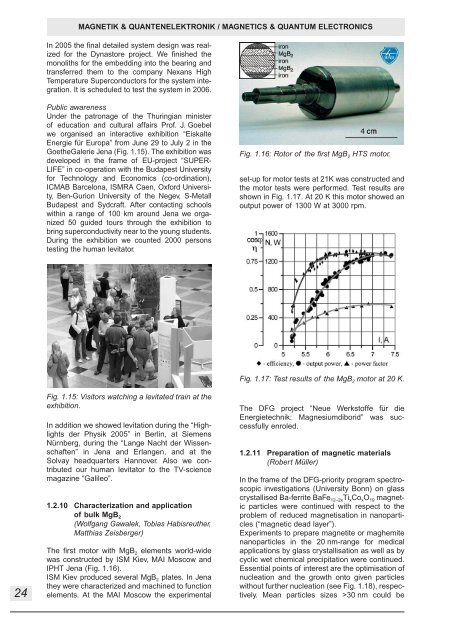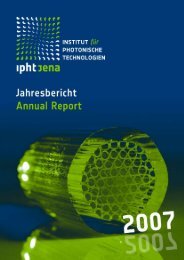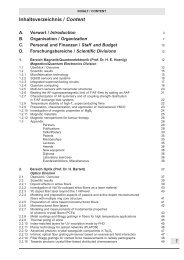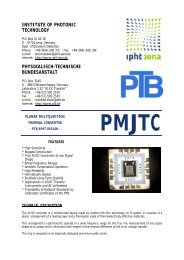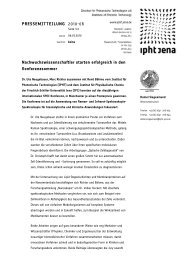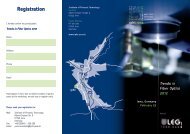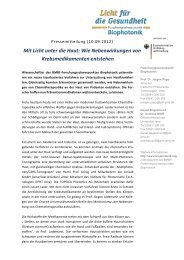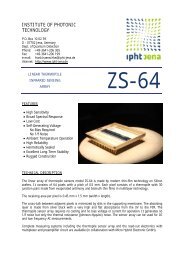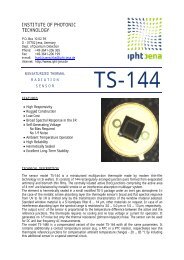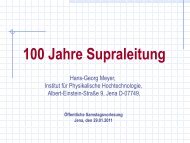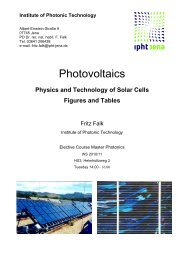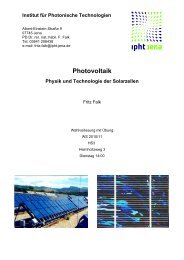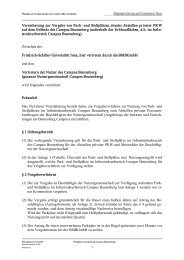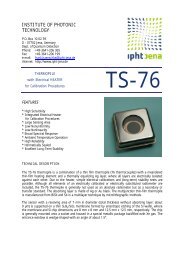Jahresbericht 2005 - IPHT Jena
Jahresbericht 2005 - IPHT Jena
Jahresbericht 2005 - IPHT Jena
Create successful ePaper yourself
Turn your PDF publications into a flip-book with our unique Google optimized e-Paper software.
24<br />
MAGNETIK & QUANTENELEKTRONIK / MAGNETICS & QUANTUM ELECTRONICS<br />
In <strong>2005</strong> the final detailed system design was realized<br />
for the Dynastore project. We finished the<br />
monoliths for the embedding into the bearing and<br />
transferred them to the company Nexans High<br />
Temperature Superconductors for the system integration.<br />
It is scheduled to test the system in 2006.<br />
Public awareness<br />
Under the patronage of the Thuringian minister<br />
of education and cultural affairs Prof. J. Goebel<br />
we organised an interactive exhibition “Eiskalte<br />
Energie für Europa” from June 29 to July 2 in the<br />
GoetheGalerie <strong>Jena</strong> (Fig. 1.15). The exhibition was<br />
developed in the frame of EU-project “SUPER-<br />
LIFE” in co-operation with the Budapest University<br />
for Technology and Economics (co-ordination),<br />
ICMAB Barcelona, ISMRA Caen, Oxford University,<br />
Ben-Gurion University of the Negev, S-Metall<br />
Budapest and Sydcraft. After contacting schools<br />
within a range of 100 km around <strong>Jena</strong> we organized<br />
50 guided tours through the exhibition to<br />
bring superconductivity near to the young students.<br />
During the exhibition we counted 2000 persons<br />
testing the human levitator.<br />
Fig. 1.15: Visitors watching a levitated train at the<br />
exhibition.<br />
In addition we showed levitation during the “Highlights<br />
der Physik <strong>2005</strong>” in Berlin, at Siemens<br />
Nürnberg, during the “Lange Nacht der Wissenschaften”<br />
in <strong>Jena</strong> and Erlangen, and at the<br />
Solvay headquarters Hannover. Also we contributed<br />
our human levitator to the TV-science<br />
magazine “Galileo”.<br />
1.2.10 Characterization and application<br />
of bulk MgB 2<br />
(Wolfgang Gawalek, Tobias Habisreuther,<br />
Matthias Zeisberger)<br />
The first motor with MgB 2 elements world-wide<br />
was constructed by ISM Kiev, MAI Moscow and<br />
<strong>IPHT</strong> <strong>Jena</strong> (Fig. 1.16).<br />
ISM Kiev produced several MgB 2 plates. In <strong>Jena</strong><br />
they were characterized and machined to function<br />
elements. At the MAI Moscow the experimental<br />
Fig. 1.16: Rotor of the first MgB 2 HTS motor.<br />
set-up for motor tests at 21K was constructed and<br />
the motor tests were performed. Test results are<br />
shown in Fig. 1.17. At 20 K this motor showed an<br />
output power of 1300 W at 3000 rpm.<br />
Fig. 1.17: Test results of the MgB 2 motor at 20 K.<br />
The DFG project “Neue Werkstoffe für die<br />
Energietechnik: Magnesiumdiborid” was successfully<br />
enroled.<br />
1.2.11 Preparation of magnetic materials<br />
(Robert Müller)<br />
In the frame of the DFG-priority program spectroscopic<br />
investigations (University Bonn) on glass<br />
crystallised Ba-ferrite BaFe 12–2xTi xCo xO 19 magnetic<br />
particles were continued with respect to the<br />
problem of reduced magnetisation in nanoparticles<br />
(“magnetic dead layer”).<br />
Experiments to prepare magnetite or maghemite<br />
nanoparticles in the 20 nm-range for medical<br />
applications by glass crystallisation as well as by<br />
cyclic wet chemical precipitation were continued.<br />
Essential points of interest are the optimisation of<br />
nucleation and the growth onto given particles<br />
without further nucleation (see Fig. 1.18), respectively.<br />
Mean particles sizes >30 nm could be


